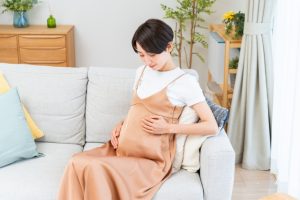How much does childbirth cost?
Many people who are giving birth for the first time may not know exactly how much money they will need.
Pregnancy and childbirth are joyous events and not illnesses, so as you know, they are not covered by health insurance. Therefore, prenatal checkups and examination fees alone can cost roughly 100,000 yen, and when it comes to childbirth, a normal delivery can cost around 300,000 to 700,000 yen. If you add in maternity supplies during pregnancy and clothes and other necessities for the baby after birth, the total can be around 500,000 yen, and some people can spend as much as 1 million yen.
If you use all public systems, the cost of childbirth will be around 520,000 yen for a full-time housewife, while a mother who plans to return to work can receive support of over 2 million yen if her monthly income is around 200,000 yen.
Money available to all pregnant women
There are three types of money that all mothers who become pregnant or give birth can receive. These money can be received by all mothers regardless of their working status.
- Subsidies for pregnancy checkups
- Lump-sum childbirth and childcare allowance
- Child Allowance
So let’s take a look at each one.
Subsidies for pregnancy checkups
Prenatal checkup costs are generally not covered by health insurance except in emergencies, so you must pay 100% of the cost. The average cost of one checkup is about 5,000 yen, so the total cost of prenatal checkups until delivery is quite high, at about 100,000 yen.
Subsidies for prenatal checkups are a system in which local governments cover part of the cost. Subsidies are covered by public funds from each prefecture, but there are significant differences between municipalities, and the number of subsidies and the amount of subsidy available vary.
It is said that the average number of prenatal checkups is 14, so all local governments will provide subsidies for a minimum of 14 checkups.
The subsidy method is that pregnant women are given vouchers for 14 health checkups, which is generally considered the recommended number of visits, and they can use these vouchers to reduce their financial burden.
Lump-sum childbirth and childcare allowance
The Lump Sum Childbirth and Childcare Allowance is one of the most representative systems to support childbirth.
The basic payment is 420,000 yen per child born, meaning that all pregnant women living in Japan who are health insurance subscribers or dependents of their spouse’s health insurance can receive it when they give birth.
The costs of childbirth, such as delivery and hospital fees, usually cost more than 420,000 yen, but recently many hospitals have introduced a “direct payment system” under which the childbirth and child-rearing lump sum is paid directly to the hospital from health insurance. This means that when you are discharged from the hospital, you only have to pay the amount over 420,000 yen.
On the other hand, if the birth expenses are less than the amount paid, you can apply to your medical insurer to have the difference refunded. For example, if the birth expenses are 400,000 yen, the lump-sum birth and childcare allowance of 420,000 yen – birth expenses of 400,000 yen = 20,000 yen, so the difference of 20,000 yen will be paid. Make sure to apply for anything you can get.
You can rest assured that the medical institution will provide you with thorough support regarding the procedures for the “Direct Payment System.”
Child Allowance
Child allowance is a subsidy for families with children from birth to junior high school graduation . In the past, it was called “child allowance.” If you apply for it when you register the birth at the city hall, you can start receiving it from the following month.
The amount varies depending on the municipality, but the following is a guideline.
- 0 to 3 years old: 15,000 yen/month
- From age 3 until completion of elementary school: 10,000 yen/month (15,000 yen/month for the third child and onward)
- Junior high school students: 10,000 yen/month
Starting in fiscal 2012, there will be a limit on who can receive the allowance depending on their income, and if their income exceeds a certain level, they will no longer be able to receive the child allowance. However, a special allowance of 5,000 yen per child per month will be paid.
If you save little by little without using child allowances, you can save nearly 2 million yen by the time your child graduates from junior high school, which will easily be enough to cover part of their educational expenses for high school, university, etc.

Money that working moms can get
Working mothers are also provided with the following benefits:
- Maternity Allowance
- Childcare leave benefits
Maternity Allowance
Maternity allowance is a financial system that working mothers, either as company employees or public servants, can receive from their employer’s health insurance.
As the due date approaches, you will have to take some time off work and will not receive a salary during that time. Maternity allowance is money to support the life of mothers who are unpaid during maternity leave or childcare leave. This support for working mothers has become more generous in recent years.
By the way, this is completely different from the Childbirth and Childcare Lump-Sum Grant, which has a similar name. As mentioned above, the Childbirth and Childcare Lump-Sum Grant is money paid for each baby, regardless of whether you are working or not.
The amount you receive will vary depending on your salary and the date of birth, but the payment will be 2/3 of your average standard monthly salary over 12 months divided by 30 days.
The standard monthly remuneration is the amount determined by health insurance and employee pension insurance, calculated based on the total amount of basic salary, commuting allowance, etc. You can calculate it yourself, but your health insurance association will tell you the exact amount.
Childcare leave benefits
To put it simply, childcare leave benefits are money that moms and dads receive from employment insurance in lieu of a salary because they have no income during childcare leave.
Childcare leave, or parental leave, is a legally determined leave that workers who have the responsibility of raising children can take, but the fact that they are unpaid during their leave is a major problem. Therefore, in order to support people’s lives during parental leave, the government provides benefits that make it easier for them to take parental leave, on the premise that they will return to work after the leave.
The payment period is from the day after the end of the maternity leave period until the day before the child turns one year old. If there are circumstances such as a waiting list for admission to a nursery school, the payment period may be extended by application until the child turns two years old.
Childcare leave benefits are paid through employment insurance via the company, but you must apply for them every two months.
In addition, there are various conditions to be met in order to receive childcare leave benefits, such as:
- Have a child under 1 year old (*Can be extended to 1 year and 6 months or 2 years old depending on circumstances)
- Enrolled in employment insurance
- During the two years prior to taking childcare leave, you have worked 11 days or more per month for at least 12 months.
- For each month of childcare leave, you are not paid more than 80% of the salary you were receiving before the leave began.
- The number of days worked during parental leave is 10 days or less per month
If you are a full-time employee, you probably meet the above conditions. However, if you are a part-time or contract employee, you should be careful. Make sure to check the contents of your contract carefully.

What is NIPT (New Prenatal Testing)?
Many pregnant women become anxious about many things during pregnancy, and many are endlessly worried about whether their baby will be born safely or what might happen if the baby has a congenital chromosomal abnormality.
Have you heard of NIPT (non-invasive prenatal testing) , a new type of prenatal testing that is attracting attention from pregnant women ? NIPT (non-invasive prenatal testing) is a test that detects the DNA of the baby in the womb from a small amount of blood from the pregnant woman and checks for chromosomal abnormalities.
If you are planning to give birth at an older age or would like to know the condition of your baby as soon as possible, why not consider this as an easy test to take?
summary
Knowing that there are various systems in place to provide financial support from local governments during pregnancy and childbirth will help you give birth with peace of mind.
It is important to know how to prepare for the long life that will follow after giving birth, the costs of childcare and education, the cost of buying a home, and other important financial matters at key times in life. After a child is born, you will be busy raising the child, so it is important to think carefully about this before the child is born.
Article Editorial Supervisor

Private: Dr. Hiroshi Oka
NIPT Specialist Clinic, Doctor of Medicine
Graduated from Keio University, School of Medicine
 中文
中文






















